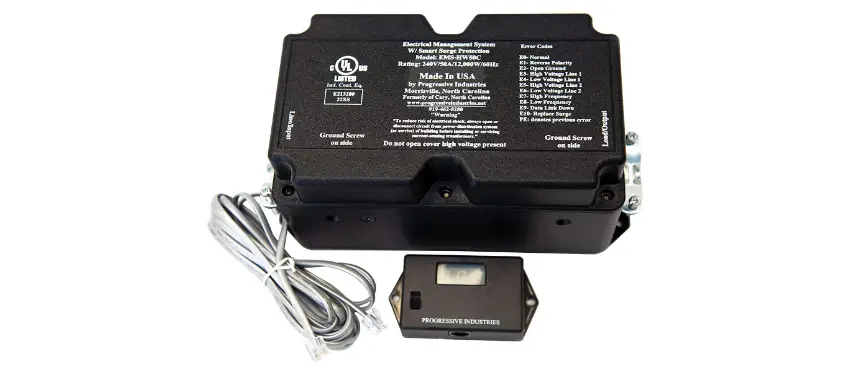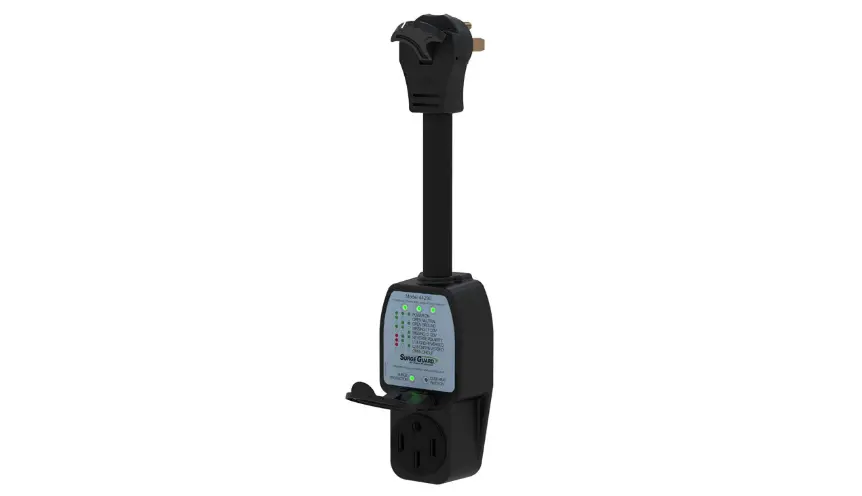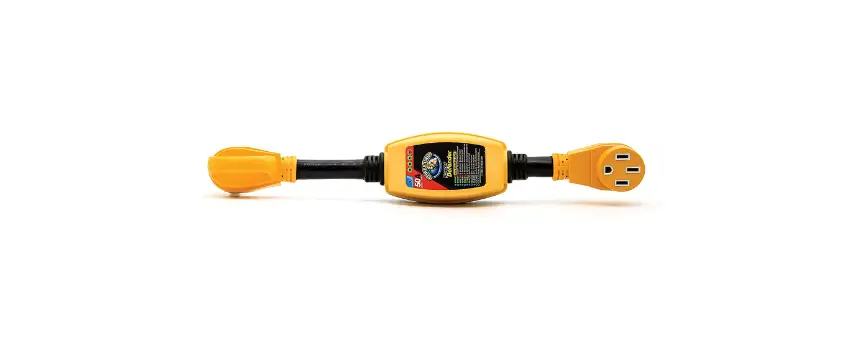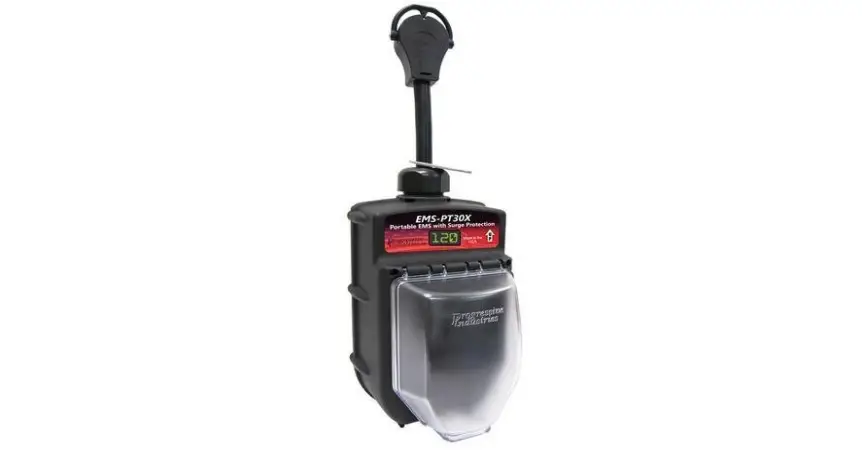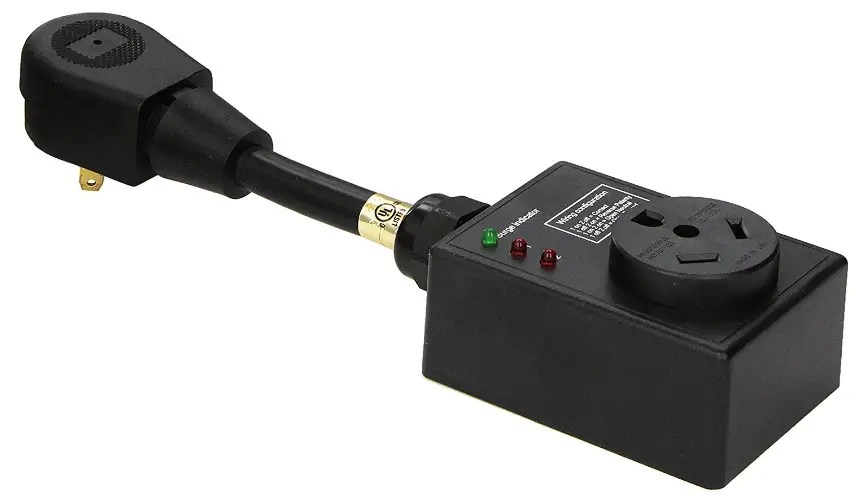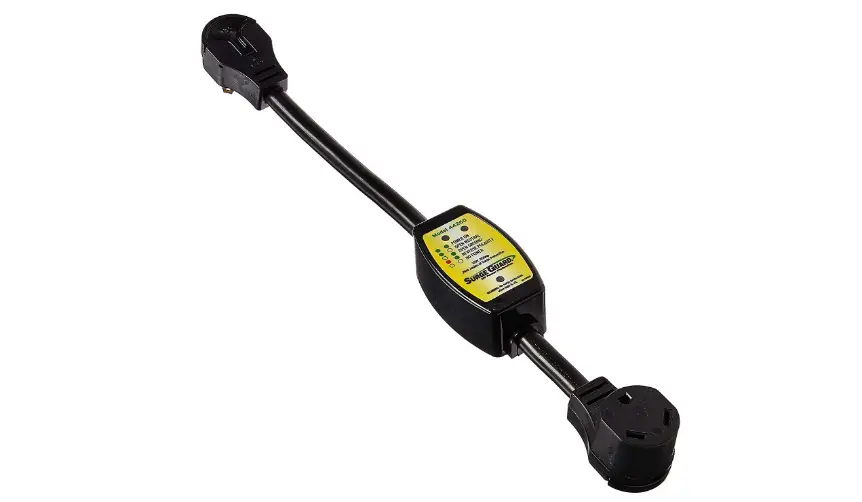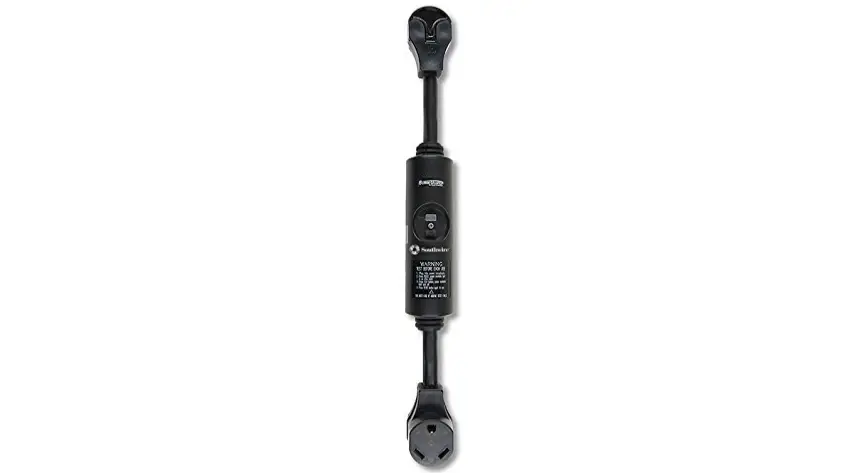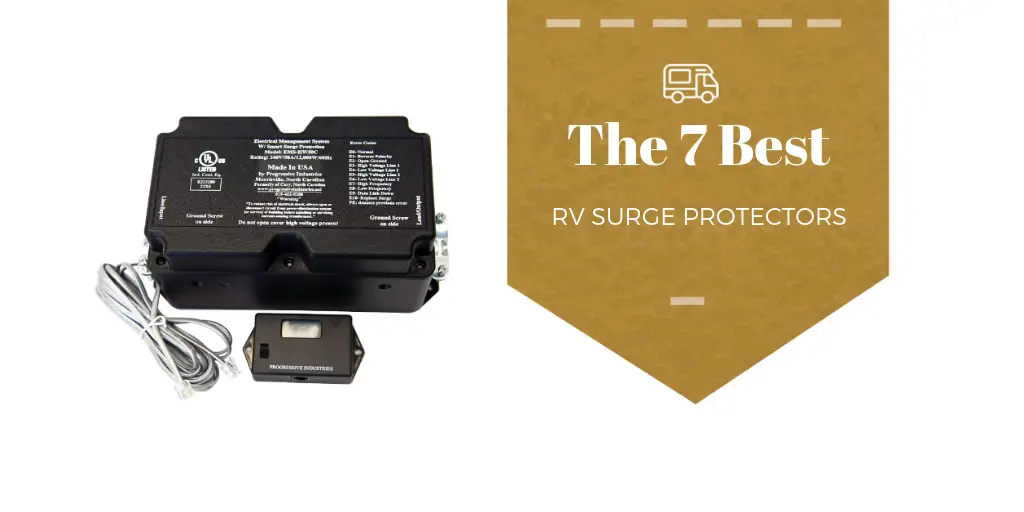
7 Best RV Surge Protectors
If you’re an RV owner, you probably drive around with a number of electrical appliances in your rig. These can include essentials like RV refrigerators and RV air conditioners to entertainment appliances like RV TVs. In either case, it’s important to protect these appliances using RV surge protectors.
Power supplies can fluctuate. If the supply goes too high or too low, it can negatively affect all your electrical appliances. Under certain unfortunate circumstances, an unsteady power supply can blow out your appliances, which would entail a great cost to get them all repaired or replaced.
An RV surge protector is a device designed to protect electrical appliances from drastic voltage fluctuations. A standard surge protector can be plugged into the campground’s power outlet before you plug your RV to it. This will protect all your appliances from a sudden upsurge in electricity as a result of lightning or other factors.
Advanced surge protectors can protect your RV from low or high voltages by adjusting the power, preventing your RV appliances from being damaged. It can also protect you in case of miswiring.
RV surge protectors function by determining whether the source of power is neutral or grounded. You have to simply plug your RV’s power cord into the surge protector and then flip on the breaker. Within a few minutes, the surge protector will start tracking the incoming power and all its conditions like frequency, voltage, polarity, etc. If there are any sudden or drastic changes, the it will automatically cut power to your RV.
You have to be very careful when choosing an RV surge protector — the well-being of all your appliances depends on it. You need to carefully consider a number of factors. Do you need a 30 Amp or 50 Amp surge protector? Should it be hard-wired or portable? Is it weatherproof? These are all important questions you need to address. In this section of the article, I’ll give you a complete overview of RV surge protectors so you can make an informed decision.
Table of Contents
Why do I need an RV Surge Protector?
It only takes one faulty wiring or one electrical upsurge, or one unfortunate circumstance to blow out all the wiring in your RV, killing all your appliances. Some people are lucky and they can go without using a surge protector for decades and not come across a mishap. But there are also those who have experienced such a situation and have been burdened with tens of thousands of dollars in damages.
You need an RV surge protector because there are a number of different cases in which you can suffer electrical damage, as follows:
Power Surge
Sometimes, too much power flows through the electrical wires to your RV appliances, blowing their circuits. This occurs mostly as a result of lightning strikes that create a sudden voltage upsurge. As such, when there’s a storm or lightning in the vicinity, it’s best to unplug all your electrical appliances, even if you have a power surge in place. However, in case you are plugged in and a power surge occurs, your surge protector will save your appliances, even if it gets fried in the process.
Faulty Wiring
Human error can happen. All it takes is a single faulty wiring or wiring that has either disintegrated or come undone, and it could fry all your electrical appliances. Sometimes electricians don’t understand the nuances of working on RVs so that can lead to a costly error. However, an RV surge protector will buffer these human errors and keep your appliances safe.
Low Voltage
Both low and high voltage can be equally damaging. Sometimes, if too many appliances are consuming energy from a single source, it can lead to a brownout. For example, if you’re in a campground during peak summer and a single power source is being used to supply power to dozens of air conditioners, the voltage can become thin.
If your RV gets voltage below 104 VAC, your electrical appliances can be seriously damaged. However, if you’re using a surge protector, it will shut off power altogether and keep your rig safe.
What are the different types of RV Surge Protectors?
Primary Surge Protector
Primary surge protectors are attachments that can be plugged into an electrical outlet. These protectors have greater visibility and can provide most of the protection against electrical surges. Not only can they protect RV appliances, but also all the inner wirings. However, effectiveness and power also mean that they’re larger and thus harder to manage and install.
Secondary Surge Protector
This is the most common type of RV surge protector. It’s small and portable, so it can be connected to any electrical outlet. These aren’t as powerful as primary surge protectors, but they can easily be carried around and are favored by RV users.
Power Strip
This is a form of secondary surge protector. It can be connected to a power outlet and has several sockets so you can connect multiple appliances to it simultaneously. These are generally used to completely cut off power in case there are any fluctuations.
Uninterrupted Power Supply RV Surge Protector
These RV surge protectors run on a battery, and they’re available in a number of different styles. Like the power strip, they immediately cut off power in case of fluctuations, thus protecting your appliances.
In this article, I’ll help you keep all your appliances safe by choosing the best RV surge protector for your needs. I’ve compiled this list after carefully vetting dozens of the best RV surge protectors on the market.
1. Progressive Industries HW50C
The Progressive Industries HW50C is one of the best hard-wired 50-amp RV surge protectors on the market, rated at 3580 joules and 88,000 amps. They offer complete protection for RVs utilizing 50-amp electricity. Furthermore, since it’s a hard-wired surge protector, it will be permanently installed in your RV.
These protectors offer instant electrical surge protection, reacting within a fraction of a second and immediately disconnecting the power supply to your RV in case of fluctuations or electrical problems. After disconnecting, they reattempt the connection after a 136-second delay once the problem is fixed. In addition to protecting you from external conditions, they also protect your RV from human folly. If you accidentally plug them into a 240-volt power source, they will not function.
They are also equipped with a legible LED display that constantly provides readings of the electrical quality received by your RV. They display vital information — line voltage, frequency, amps, and others — with a 2-second delay. The display is mounted on an external compartment, so it can be monitored while you’re connecting to shore power.
Before connecting the surge protector, you should make sure that the 50-amp circuit breakers are shut off at the power source. Once confirmed, connect the RV cord into the 50-amp receptacle in the power source and turn the 50-amp circuit breaker on. Gauge the line condition from the display screen. It will start providing shore power to your RV after a short 136-second delay and then continue monitoring the electricity.
The cable that comes with it is 14’ in length. However, you can use a 4-conductor phone cable to extend the length. You can also contact the manufacturers to provide a custom length cable at the rate of $1.25 per foot.
One of the biggest drawbacks of this surge protector is the buzzing sound it generates. The sound isn’t too loud. However, it is discernible, especially at night, since it is installed inside the RV itself. I would recommend not installing this in the same room where you sleep as it might be disturbing.
Pros
- A single installation is all it takes.
- Complete protection from all power-related issues.
- Cannot be stolen.
- Display can be read from inside the RV.
- Reasonable.
- Comes with a lifetime warranty.
Cons
- Since it’s a hard-wired surge protector, you may need external help to install it, which will cost extra.
- Generates a buzzing sound.
2. Surge Guard 44290
The Surge Guard 44290 is a portable 50-amp RV surge protector rated at 4200 joules and 65,000 amps. This is not an advanced surge protector so it can only provide protection against voltage upsurge, such as those caused by lightning. A surge guard 44290, as such, is a budget-friendly option for those who need the most basic surge protection.
These units come with an LED display that indicates electrical issues. You will be made aware of reverse clarity issues, open ground or neutral conditions, and the amount of electricity flowing. However, they don’t cut off the power supply during fluctuations. As such, when using a Surge Guard 44290, you need to be vigilant and take the initiative to cut off the power supply if you notice any issues.
There are three light indicators at the top of the device. After you connect the surge protector, these three indicators should be green to ensure there are no faults at the power source. The LED light at the bottom should also be green to denote that the device is working perfectly. You should only go ahead and connect your RV’s shower power cord to the surge protector when you see that all indicators are green.
This surge protector comes with an overheat indicator that will start flashing when the plug or receptacle overheats. In case there are any faults, based on the LED lights, you should refer to the operation manual or seek technical assistance to figure it out.
This surge protector is perfectly weather resistant so you can connect it outside even if it’s raining heavily. To imitate rain, I sprayed it with a shower of water and didn’t notice any issues. However, I have spoken to several other users of this surge protector and complain that their device gets flooded with water seeping into the body. As a result, I believe the manufacturers need to address some of the inconsistencies with this product.
This surge protector also comes with an anti-theft lock ring on the cord. This is an essential feature since portable surge protectors are connected to the power source outside the RV and are thus vulnerable to theft. However, even with the anti-theft lock ring, a determined thief will still be able to get to it. The anti-theft lock will only buy you more time to catch the thief in action or deter the person from trying.
Pros
- Can protect from power surges.
- No installation is necessary. Simply connect and operate.
- Lifetime warranty available.
Cons
- It does not automatically stop power supply in case of any issues other than a voltage upsurge.
- Even though a lock is available, it can be easily taken apart and stolen.
- Has to be plugged into the campground every time you move.
- If the power source is low, it can even touch the ground, which is not advisable.
3. Camco Dogbone 55313
The Camco Dogbone 55313 is a portable 50-amp RV surge protector rated at 4200 joules. It comes with diagnostic lights that indicate if there are any faults with the connection before you connect the RV’s power cords to the electrical outlet. It’s also weather resistant so you can connect it outdoors even during rain and thunderstorms.
The biggest drawback here is vulnerability. Portable surge protectors such as these are left vulnerable outside an RV. Anyone can simply disconnect and steal it. Unlike a lot of other surge protectors, this one doesn’t come with an anti-theft lock system. To secure the device, I had to use a bicycle cable to lock the handles around the power supply’s pole. It can still be stolen, but the thieves would have to smash the handles or cord, and most people wouldn’t take the risk.
It’s weatherproof so you don’t have to worry about rain and thunderstorms. I’ve tested it by running it through a shower several times, and it never gives away. However, you should keep it on an elevated position above ground so it doesn’t get submerged. I tried soaking it in a bucket and that didn’t work out. So it’s okay if the device gets wet, just don’t let it drown.
If I were to get nit-picky, I’d also say that the indicator lights aren’t very bright during the day. You have to really get up close to see the indicator lights when it’s bright outside. However, at night, they’re perfectly visible. Furthermore, some product users have stated that it gives faulty indications occasionally, causing you to disconnect appliances even when everything is alright. That makes this product slightly untrustworthy as well.
Pros
- Budget-friendly.
- Easy to read and understand.
Cons
- Can only be used to identify electricity issues; it does not automatically stop the power supply.
- Difficult to plug into the power outlet at times.
- Indicator lights aren’t completely reliable.
- Vulnerable to thefts and it doesn’t come with an anti-theft lock.
Best 30 AMP RV Surge Protectors
4. Progressive Industries PT30X
The Progressive Industries PT30X is a portable 30-amp RV surge protector rated at 1790 joules and 44,000 amps. This is a complete Electrical Management System (EMS) providing complete surge protection. It can also identify various other electrical issues and turn off the power supply to the RV within nanoseconds.
Many portable surge protectors only have the ability to protect your RV from a sudden electricity upsurge and they cannot automatically turn the power off under other circumstances. This is where the Progressive Industries PT30X differs. It’s an advanced surge protector even though it’s small and portable. It continually monitors the shore power being provided to your rig and reacts within a fraction of a second if there’s a surge condition.
If there are signs of high or low voltage, this surge protector will turn the power off after 6 seconds of sustained high or low voltage. Once the voltage has stabilized for a few seconds, it starts supplying power again. As such, not only does it cut power off in time, but it also resumes it automatically. This surge protector also monitors the electrical wiring to see if it’s open ground, neutral, or a reverse polarity condition. In these conditions, it will turn the supply off.
After a fault is detected and addressed, this surge protector restores power after a 136-second countdown to prevent air conditioner compressor damage. During this period, you should gauge the LED display to make sure it’s displaying the EO sign that indicates normal operations.
It’s completely weather-resistant and comes with a Lexan housing all-weather shield that protects not just the surge protector itself but also the shore power cord’s entrance into the electrical unit.
A minor issue I have with this powerful 30-amp surge protector is the connection itself. It’s quite heavy for a portable surge protector and, as such, it has trouble firmly connecting to some power outlets. When this happened, I had to resort to using a Python lock or bungee cords. The manufacturer should address this issue so this model can be used with all power outlets and stations.
Pros
- It protects the RV from all power-related issues.
- No installation is necessary it can simply be connected and used.
- Comes with a lifetime warranty.
- Has an inbuilt locking bracket.
- Equipped with a Lexan housing all-weather shield.
Cons
- Expensive.
- Can be stolen even if locked.
- Can only be used vertically.
- Doesn’t fit perfectly into all power stations.
5. Progressive Industries SSP30
The Progressive Industries SSP30 is a portable 30-amp RV surge protector rated at 825 joules and 22,500 amps. Like most portable surge protectors, it does not need any installation. You simply connect it to the RV park’s power hookup and get started.
This is more of a surge indicator rather than a surge protector. Yes, it can protect you from overheating and an upsurge up to the small capacity of 825 joules, but it’s largely ineffective beyond that point. Furthermore, in most cases, the indicators only warn you if the pedestal is wired incorrectly, check for polarity, etc.
It features a number of LED light indicators that can be used to determine various electrical issues. If there’s a massive surge failure, it automatically turns off the power supply. However, in most other cases, it can only warn you through indicators; it doesn’t automatically turn the power off. It can warn you of faulty wiring and issues like open ground, reverse polarity, and neutral.
The biggest issue with this product is that it’s not weatherproof. This is a major oversight because portable surge protectors are connected outside an RV. As such, every time it starts raining, you’ll have to disconnect it and bring it inside. Upon spraying some water on it, it immediately seeped into the body of the surge protector and corrupted it. It’s extremely unwise to get a portable surge protector that isn’t waterproof, even if you live in a dry area.
The manufacturers don’t provide any locking mechanism with this device. As such, it can easily be stolen by someone within a few seconds. I personally had to use a cable lock to wrap around the power pole and fasten it in place. You can also purchase a “lock hasp”, a box that hinges around the unit and fastens the device to the power pole using a padlock. In either case, you have to rely on external locking mechanisms whereas it should be the manufacturer’s responsibility to provide a complementary anti-theft lock.
Pros
- Extremely lightweight and portable.
- Easy to use.
- Doesn’t have to be installed.
- Can connect to most electrical outlets.
- Indicator lights are bright.
- Turns power off in case of surge failures.
Cons
- Not weather or waterproof.
- Cannot protect your RV appliances from serious power surges and will most likely blow off during lightning strikes.
- More of a surge indicator than a surge protector.
- Doesn’t come with an anti-theft lock, so it can easily be stolen.
- Can only withstand 825 joules of energy, beyond which it is likely to get corrupted.
6. TRC Surge Guard 44260
The TRC Surge Guard 44260 is a portable 30-amp RV surge protector rated at 2100 joules. I used this surge protector for approximately 2 months and experienced on and off rain storms for about one whole week within that period. As such, I have used this extensively during both wet and dry weather conditions. It never failed no matter how hard the rainstorm got.
The male plug has been designed with a low profile so it can easily fit into receptacle covers. However, it has a little handle at the end with which you can easily pull it out as well. The indicator lights, however, are almost impossible to see in sunlight so I would suggest keeping some kind of a shade under it to see the lights. At night, they’re really bright so that won’t be much of an issue. There are a total of 3 LED lights on this device: two at the top and one at the bottom. The face plate also bears color markings, serving as a guide to what the lights indicate. The lights at the top are related to pedestal issues and those at the bottom are related to the surge guard’s functionality.
In terms of functionality, this surge guard can only do two things — check the polarity provide protection against an upsurge. It is not equipped to protect against low voltage, and it won’t automatically cut power off in that case. You should also note that this unit will only last for a single power surge as it will get fried and you’d have to get another one. I didn’t experience a power surge, thankfully, when I had this device. However, I spoke to several users who had experienced power surges and they concurred that it’s a one-trick pony.
This surge protector comes equipped with a lock hasp device to secure it. As such, if someone tries to steal it, they’ll have to first break the lock; but you’ll have plenty of time to react to it.
Pros
- Offers 2,100 joules of protection, which is pretty impressive for a 30-amp portable surge protector.
- Doesn’t have to be installed; can simply be plugged in.
- Can identify faulty wiring in campgrounds.
- Weather and water resistant.
- Comes with a Lock Hasp to secure it.
Cons
- The indicator lights are weak so the warnings may be missed.
7. Technology Research 44750
The Technology Research 44750 is a portable 30-amp RV surge protector rated at 510 joules. This surge protector comes with a shock shield perfect for use in RVs and trailers. It has an extremely limited joules rating, so it is likely to get fried even with a small upsurge. However, it will prevent your RV appliances from getting fried in the process. In addition to protecting you from surges, it can also indicate — via LED lights — issues related to your electric current.
If it encounters a surge, this device will turn off on its own, but the aftermath of the surge is not handled well. Most devices automatically resume the power supply after a 136-second delay, while this surge protector stays turned off until you manually reset it. As such, if you leave your RV and go somewhere for the day and there’s a power surge while you’re away, it will turn off the power supply and won’t resume. I had to learn this the hard way. The device tripped up while I was away and I returned to find that all of the ice in my refrigerator had melted and some of my food items had gone bad because the device didn’t automatically restore power. Despite the nuisance of wasted food and melted ice, I’m happy that it at least protected all my electronics and no significant damage was incurred.
One of my biggest issues with this model is that it doesn’t have sufficient LED indicators. It doesn’t have lights that warn you when there’s faulty wiring, or low voltage, or if the device is not functioning optimally. Even if the device isn’t working perfectly, you won’t realize it. This can prove to be dangerous in certain situations.
Basically, if you want a cheap and portable surge protector to keep your electronics safe from shorts and electrical spikes, this device is great. However, if you want a device that can also protect you from low voltage — which is far more common in campgrounds and trailer parks — it is not suitable.
Pros
- Equipped with a shock shield.
- Weather and water resistant.
- Has ergonomic plug handles.
- Whenever there are ground faults, it automatically turns off the power supply.
Cons
- No protection from low voltage.
- Limited joules rating.
- Will get fried with a single massive power surge.
- Doesn’t reset automatically after a power surge.
- No LED lights.
Which Factors to Consider when Buying RV Surge Protectors?
The following are some of the most important factors to consider before buying an RV surge protector.
Number of Ports
Most surge protectors come with 4 ports. But you can also find surge protectors with up to 12 ports. You should determine how many you need based on the appliances that will be connected to them.
Amp Rating
Amperage is the amount of electricity present in an electrical current. All devices need a certain amount of electricity to perform, and they fail to work if they don’t receive enough electricity.
The amp rating of the surge protector determines the power to use when you plug your RV into an electrical outlet. Most RV surge protectors are available in 30-amp or 50-amp ratings. If your protector has 3 prongs, it’s a 30-amp model. If it has 4 prongs, it’s a 50-amp protector.
Joules Rating
The Joules rating indicates the level of protection your surge protector can offer. The surge protector is supposed to dissipate heat during energy surges, and this property is determined by the joules rating. As such, you should look for a device with a high joules rating that can protect you against overheating.
Underwriter’s Laboratory Seal
The Underwriter’s Laboratory (UL) Seal is the official certificate indicating that the RV surge protector functions as it should. Those with a UL seal are generally trustworthy.
Weight
If you plan on transporting your RV surge protector often, you should look for a lightweight option.
Display
Look for an RV surge protector with an LED display that can indicate the amount of electricity or voltage passing through. In case there are any fluctuations, the display will immediately inform you.
Portability
RV surge protectors are available in two types based on their portability — portable and hard-wired.
Portable
These surge protectors are connected to the female outlet of the power pedestal. As the name suggests, they are portable. As such, you can test an outlet first before you park your RV, and they are easy to replace and install in case they get fried.
However, portable surge protectors also have their drawbacks. They can be easily stolen. And if the power outlet is low, the surge protector might be in contact with the ground, which is ill-advised during wet conditions.
Hard-Wired
These surge protectors are permanently fixed inside your vehicle, placed between the power outlet and the RV’s electronics. Since they are located inside the RV, you can check the display any time and gauge the electricity condition without stepping out. You also don’t have to worry about bad weather or rain. Furthermore, since they are located inside the RV, they can’t be stolen.
The cons of a hard-wired surge protector are that they are difficult to remove once installed, and they have to be installed by a professional, which proves to be costly.
Noise
Some RV surge protectors produce noise when they’re operational. If you’re in a campground, or if the surge protector is inside the RV, a loud buzzing sound might become annoying. As such, you should look for a surge protector that doesn’t produce much noise.
Weatherproof
Some RV surge protectors are weatherproof and some aren’t. That’s why it’s important to compare all your options before making a purchase.
Most new surge protectors are weather and waterproof; however, you should still verify it. It’s well worth it to pay a little more for a weatherproof surge protector. Even if you live in a dry area that experiences little to no rainfall, you should still get a weatherproof surge protector as it can protect your device from water spills and humidity as well.
Furthermore, you should look for a weatherproof surge protector even if you’re installing a hard-wired surge protector inside your RV. This is because water spills can happen inside an RV, and waterproof surge protectors won’t be affected by them.
Installation
Try to go for an RV surge protector that’s not hard to install. Portable RV surge protectors are the easiest to install as you simply have to plug them into an outlet. Hard-wired surge protectors need more expertise during installation, and you should find one with a simple and straight-forward set of instructions.
Cost
You should find a surge protector that’s not too expensive but still meets all your basic needs as highlighted above. You should not go for the cheapest models as they might end up costing you in the long run.
How to Install an RV Surge Protector?
Installing an RV surge protector is pretty easy if you’re getting a portable unit. However, if you’re getting a hard-wired one, it can be a little more complicated.
In either case, as long as you follow the instructions closely, you should be able to install an RV surge protector yourself or with some professional help. Most RV surge protector brands provide technical support.
How to Secure RV Surge Protectors?
Most RV Surge Protectors come with locking brackets. They can be easily secured in place. Even if the locking mechanism differs for some surge protectors, they are all fairly easy to secure.
How to Use RV Surge Protectors?
Different brands and models of RV surge protectors have different instructions for use. In most cases, they are pretty easy to follow. You should get an RV surge protector with a reliable customer support system, so you can contact technical support with any questions or issues.
Cautionary Measure when Plugging into RV Surge Protectors
Before you plug into an RV surge protector, you should be cautious. Before plugging into the surge protector, make sure that the 30 or 50-amp circuit breaker is switched off right at the power source. This will prevent circuit arching between the male plug on the surge protector and the female plug on the power source.
Conclusion
I hope this article has helped you select the best RV surge protector for your needs. As you can see, you have a lot of options. Should you get a portable or hard-wired surge protector? Should you get a 30 Amp or 50 Amp surge protector? Answer these questions wisely and you’ll be able to protect all your RV appliances!



